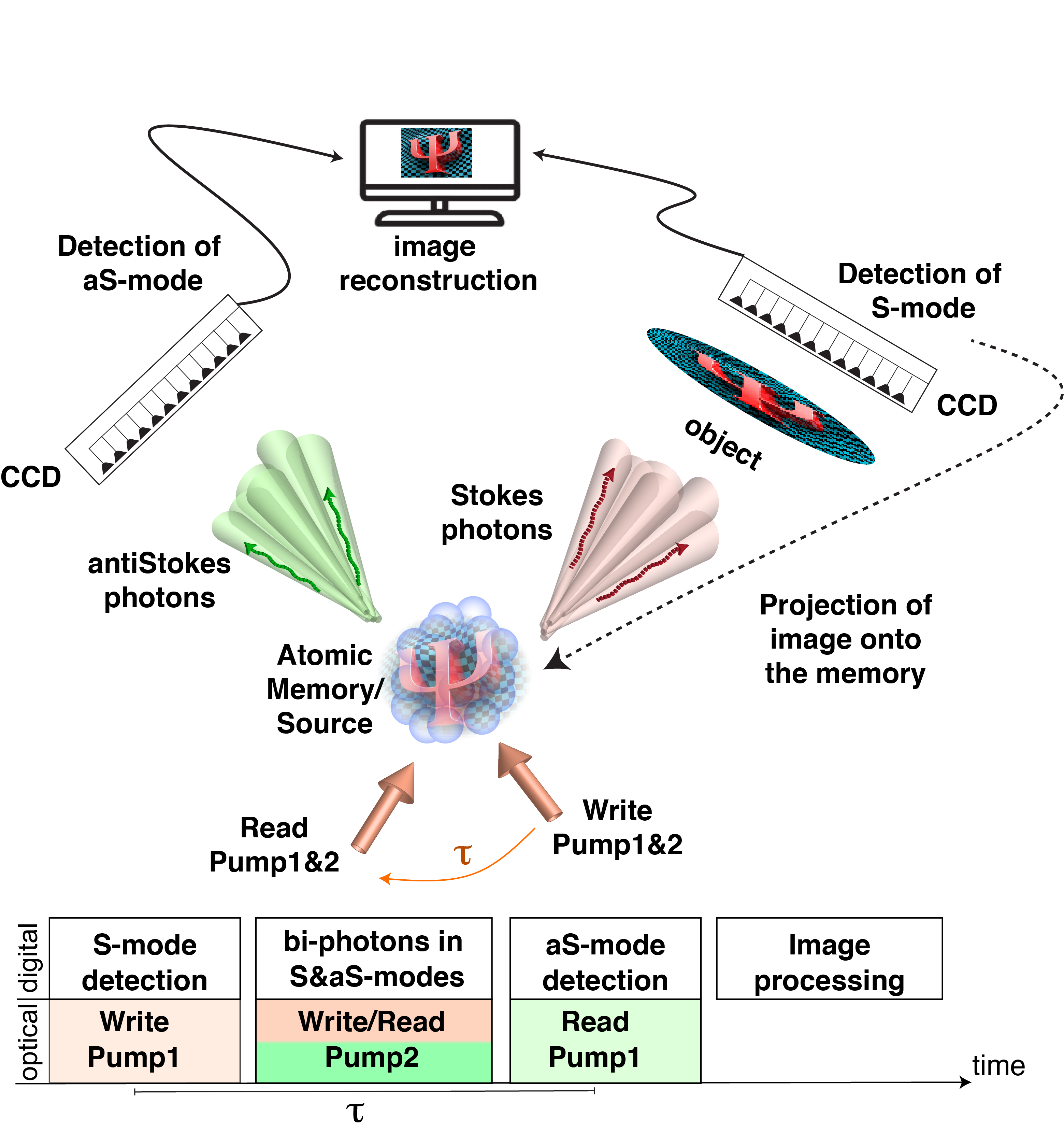Research
Quantum Storage and Quantum Imaging With Room-Temperature Atoms
Introduction. As a new frontier, quantum information technology promises vastly powerful computing and perfectly secure communication, while introducing its own complications. Unlike conventional optical information systems, quantum optical data cannot be stored as a set of measurement results. A requirement of a quantum memory is that information should be stored without any measurement or disturbance. Another important criterion for a quantum memory is that the efficiency of the recall must exceed 50%. This is the crucial no-cloning limit for security of information guaranteeing that nobody can eavesdrop the transmitted information by secretly reading out the memory. The laws of quantum physics, such as the no-cloning theorem, can provide novel encoding mechanisms guaranteeing the absolute security of transmitted information. Quantum information, however, is extremely fragile and susceptible to loss, and similar to classical communication, purification (amplification) of quantum (classical) information is essential for long-distance quantum communication. To implement long distance quantum communication, so-called quantum repeater systems were proposed that rely on high fidelity quantum memory devices to extend the communication distance. Quantum communication devices also need to be compatible with the telecom wavelength. There has been a significant progress towards realization of such repeater systems, however, the outstanding question still remains: Can a practical and fast quantum repeater be realized to support secure communication over long distances?
Atomic-gas quantum memory. At ANU, we have developed an efficient quantum memory for optical information that works by creating a frequency gradient of atomic absorption that can be coherently reversed to recall stored information. This kind of reversible absorption is called gradient echo memory (GEM). Based on this technique, we have demonstrated a memory with arbitrary access to store optical information where a string of pulses can be stored and recalled on-demand in arbitrary order, allowing re-sequencing of the stored information.

Quantum Imaging. At Purdue, we develop room-temeprature quantum memories for storign and generating quantum light for imaging. We also develop computational imaging tecniques to process and reconstruct images.

Related Publications:
- O. Pinel, J. L. Everett, M. Hosseini, G. T. Campbell, B. C. Buchler and P. K. Lam “A mirrorless spinwave resonator", Scientific Reports 5, 17633 (2015).
- D. B. Higginbottom, J. Geng, G. T. Campbell, M. Hosseini, M. T. Cao, B. M. Sparkes, J. Bernu, N. P. Robins, P. K. Lam, and B. C. Buchler “Dual-rail optical gradient echo memory”, Opt. Exp. 23, pp. 24937-24944 (2015).
- G. T. Campbell, O. Pinel, M. Hosseini et al, B. Buchler, P. K. Lam “Configurable unitary transformations and linear logic gates using quantum memories”, Phys. Rev. Lett. 113, 063601 (2014).
- B. M. Sparkes, J. Bernu, M. Hosseini, J. Geng, Q. Glorieux, P. A. Altin, P. K. Lam, N. P. Robins, and B. C. Buchler “Gradient echo memory in an ultra-high optical depth cold atomic ensemble”, New J. Phys. 15, 085027 (2013).
- O. Pinel, M. Hosseini, B.M. Sparkes, D. Higginbottom, G.T. Campbell, P.K. Lam and B.C. Buchler “Gradient echo quantum memory in warm atomic vapor”, J. Vis. Exp. e50552, doi:10.3791/50552 (2013).
- B. M. Sparkes, M. Hosseini, C. Cairns, D. Higginbottom, G. Campbell, O. Pinel, P. K. Lam, and B. C. Buchler “Precision Spectral Manipulation: A Demonstration Using a Coherent Optical Memory”, Phys. Rex. X 2, 021011 (2012)
- N. Killoran, M. Hosseini, B. C. Buchler, P. K. Lam, and N. Lutkenhaus “Quantum benchmarking with realistic states of light”, Phys. Rev. A 86, 022331 (2012)
- D. B. Higginbottom, B. M. Sparkes, M. Rancic, O. Pinel, M. Hosseini, P. K. Lam, B. C. Buchler “Spatial mode storage in a gradient echo memory”,Phys. Rev. A 86, 023801 (2012)
- M. Hosseini, B. M. Sparkes, G. Campbell, B. C. Buchler, P. K. Lam “Light Storage and Manipulation using Raman Gradient Echo Technique”, J. Phys. B. 45, 124004 (2012)
- M. Hosseini, B. Sparkes, S. Rebic , J. Twamley, B. C. Buchler, P. K. Lam “Memory-enhanced noiseless cross-phase modulation”, Light: Sci. & Appl. 1, e40 (2012)
- G. Campbell, M. Hosseini, B. Sparkes, P. K. Lam, and B. C. Buchler “Time and frequency domain polariton interference”, New J. Phys. 14, 033022 (2012)
- M. Hosseini, B. M. Sparkes, G. Campbell, P. K. Lam and B. C. Buchler, “High efficiency coherent optical memory with warm rubidium vapor”, Nature Communs. 2, 174 (2011)
- M. Hosseini, G. Campbell, B. M. Sparkes, P. K. Lam, and B. C. Buchler, “Unconditional Room Temperature Quantum Memory”, Nature Phys. 7, 794798 (2011)
- B. C. Buchler , M. Hosseini, G. Hetet, B. M. Sparkes, P. K. Lam, “Precision spectral manipulation of optical pulses using a coherent photon echo memory”, Opt. Lett. 35, pp. 1091-1093 (2010)
- B. M. Sparkes, M. Hosseini, G. Hetet, P. K. Lam, and B. C. Buchler “ac Stark gradient echo memory in cold atoms”, Phys. Rev. A 82, 043847 (2010)
- M. Hosseini, B. M. Sparkes, G. Hetet, J. J. Longdell, P. K. Lam and B. C. Buchler, “Coherent optical pulse sequencer for quantum applications”, Nature 461 (7261), 241-245 (2009)
- G. Hetet, M. Hosseini, B. M. Sparkes, D. Oblak, P. K. Lam, and B. C. Buchler “Photon echoes generated by reversing magnetic field gradients in a rubidium vapor”, Opt. Lett. Vol. 33, No. 20, (2008)
